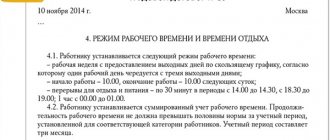An important point: if an employee voluntarily works longer than expected, such overtime work is not recognized and is not paid additionally. The employer must involve the employee in working beyond the norm, having received written consent. And in this case, management is obliged to calculate overtime work. In addition, if an employee’s employment contract establishes an irregular working day, working beyond the allotted time is also not considered overtime. Workers with irregular schedules are entitled to another benefit - additional leave.
How are overtime hours calculated?
HR and accounting department employees are required to correctly take into account the duration of work for each employee.
According to Art. 91 of the Labor Code of the Russian Federation, the normal length of working time is 40 hours per week. It is important to remember that an employee should not work beyond the norm for more than 4 hours, 2 days in a row and longer than 120 hours a year (Part 6 of Article 99 of the Labor Code of the Russian Federation). For some categories of citizens, a shortened day (24-35 or 36 hours a week) is the norm, and working beyond this time is overtime for them. The time worked must be reflected in the working time sheet, form T-12 or T-13. Overtime hours o or code 04. There is a timesheet program for calculating overtime hours, which automates filling out the timesheet and calculates payment for overtime using formulas.
Overtime work is paid at an increased rate (Article 152 of the Labor Code of the Russian Federation):
- for the first 2 hours at one and a half times;
- for the following hours - double.
Instead of increased pay, the employee can choose another option - get additional time for rest (no less than he worked overtime). In this case, processing is still paid, but at a single rate.
What is the minimum amount an employer must pay for working after hours?
Article 152 of the Labor Code of the Russian Federation does not contain an answer to this question, and officials of the Ministry of Health in a letter dated 07/02/14 N 16-4/2059436 explain the situation as follows: to pay overtime you can use the rule of Art. 153 Labor Code of the Russian Federation. According to the norm of this article, the minimum amount of double payment is a double tariff without taking into account compensation and incentive payments. According to the logic of this norm, the least that an employer must pay is the employee’s average hourly earnings without bonuses and allowances, multiplied by 1.5 or 2 and multiplied by the number of hours worked in excess of the norm. Local regulations of a particular company, labor and collective agreement may establish higher payment for overtime: allowances and additional payments are included in the calculation in whole or in part, if the employer is ready for this.
Formula for calculating overtime:
How is overtime calculated?
Despite the fact that excess work is initiated by the manager, the law does not provide for the issuance of a special order in this regard; it is only important to obtain the written consent of the employee. Although in the event of abnormal or emergency situations, the consent of the personnel is not required.
The basis for calculating overtime and subsequent payment is the working time sheet. Overtime hours are entered in it, coding with the code “C” or “04”.
Legislators have established the maximum permissible amount of overtime per year equal to 120 hours (and no more than 4 hours for two days in a row). The standard length of the working week is established by Art. 91 Labor Code of the Russian Federation – 40 hours (5 days, 8 hours). Art. 152 of the Labor Code of the Russian Federation determines increased payment for overtime:
- for the first 2 hours – one and a half times the established tariff;
- for subsequent ones - double payment.
The indicated amounts of payment for overtime hours are minimal, i.e. the employer has no right to pay less, but can increase the payment at its discretion. This information must be enshrined in the collective agreement, industry agreement or employment contracts with employees.
Calculation of overtime hours based on salary
To calculate additional payments, you need to calculate the hourly part of the salary - how much the employee earns per hour. Then pay one and a half or two times more for each hour of overtime (depending on the time worked above the norm). The formula for calculating the amount earned per hour is given in the letter of the Ministry of Health dated 07/02/14 N 16-4/2059436:
To calculate this formula, the average monthly number of working hours per year is taken - the average value for the whole year is displayed, and not the actual number of hours worked in a month.
But this is not the only method for calculating hourly earnings. There is also an option taking into account the actual working hours in a particular month. To do this, there is no need to divide the hours by 12 months; it is enough to divide the salary by the hourly work rate for a separate month:
Since there are different options, the method for calculating the hourly tariff rate must be fixed in the local acts of the company or in an agreement with the employee (collective or labor).
The norm of working time in a year or month is determined according to the production calendar (see production calendar) depending on which category the employee belongs to (whether he is entitled to a shortened working week).
Procedure for processing documents
Registration of overtime work begins with obtaining the employee’s consent to such a “labor feat” (situations when consent is not required are listed below). The Labor Code does not regulate the procedure for obtaining consent, requiring only that consent be written. Therefore, formally, the employer can receive it even after issuing an order on overtime work. But we do not recommend doing this. And that's why.
Firstly, there are categories of employees (for example, disabled people, women with children under three years of age, etc.; see the full list below) whom the employer must notify in writing of the right to refuse overtime work. Agree that the order, which states that Ivanova I.I. is involved in overtime work from 18 to 22 hours and at the same time her right to refuse such work is explained, will look ridiculous.
Secondly, not only the specified categories of employees, but also all others have the right to such a refusal (it is simply not necessary to explain this right to them in writing).
Accordingly, any employee can refuse to work overtime without any negative consequences. This means that the order will have to be redone to avoid confusion when filling out the Time Sheet and calculating compensation.
Therefore, we advise that before issuing an order, issue a notification document where the employee would sign that he agrees to work overtime. In such a document you need to indicate the period of overtime (in hours) and the start date of overtime work. In the same document, you can offer the employee to choose the form of receiving compensation - cash or in the form of additional rest (Article 152 of the Labor Code of the Russian Federation).
And only after this an order should be issued to the consenting employees. A unified form for an order to engage in overtime work has not been established, so an organization can issue it in a free form.
Typically, such an order indicates the reason for the need for overtime work. It should be noted here that Article 99 of the Labor Code of the Russian Federation contains only an approximate list of such reasons - part 4 of this article states that it is possible to engage employees overtime “in other cases” (the only difference is that “other cases” require the consent of the trade union, if there is one) .
The order also contains the names, positions and personnel numbers of employees who will work after the end of the working day; the start time of overtime work and its end time are indicated. Please note that the time for completing these documents, if it occurs after the end of the working day, is also included in overtime hours. Additionally, opposite each last name, you can indicate the details of the notification, which contains consent to overtime work. The order drawn up in this way must be handed over to employees for review, which each of them must confirm with a handwritten signature.
The time worked overtime by employees is necessarily recorded in the Working Time Sheet (forms No. T-12 or T-13, approved by Resolution of the State Statistics Committee of Russia dated 01/05/04 No. 1). For this, a special code “C” or 04 is provided, which must be combined with an indication of the number of hours worked overtime. In this case, the data in the Timesheet must coincide with the data in the order (and the order, in turn, with the documents on consent to overtime work signed by the employee). Remember also that the Labor Code prohibits working overtime for more than four hours for two days in a row and more than 120 hours per year (Article 99 of the Labor Code of the Russian Federation).
An example of calculating overtime hours with a salary
Salary of employee Malofeeva L.G. is 25,000 rubles per month. In September 2021, the employer delayed him twice: on September 1 for 3 hours, on September 8 for 1 hour. We will calculate overtime if the norm is for Malofeev L.G. 40-hour, five-day work week.
The first method (based on the average monthly number of working hours in 2016):
In 2021, the average annual working time for a 40-hour week is 1974 hours (see production calendar). Let’s calculate the hourly part of Malofeev’s salary in average form:
For overtime work on September 1, Malofeev L.G. will receive:
For September 8:
In total, the employee was credited 759.85 + 227.95 = 987.80 rubles in September 2021. for working overtime.
Second method (based on the actual number of working hours per month):
In September 2021, the average monthly working time for a 40-hour week is 176 hours (see production calendar). Let us calculate the hourly part of L.G. Malofeev’s salary. based on the actual (not average) number of working days in September:
We see that the result is a completely different amount of hourly earnings than when calculating using the first method (almost 10 rubles less). But at the same time, in another calendar month - in which the number of labor hours is less than in September - the amount obtained, on the contrary, will be greater than with the average annual calculation.
For September 1, Malofeev will receive:
For September 8:
Total for September 2021 Malofeeva L.G. overtime accrued: 710.20 + 213.06 = 923.26 rubles.
The amount turned out to be less than in the first case, which is unprofitable for the employee. The Ministry of Labor in letter No. 1202-21 dated 08/09/2002 recommends using the first method of calculating overtime if this improves the employee’s financial situation.
Calculation of overtime hours on a shift schedule
According to Art. 103 of the Labor Code of the Russian Federation, a shift schedule implies work in two, three or four shifts, the need for which is determined by the continuity of the production process. Shift work must be fixed in the employment contract with the employee, since it is its essential condition. If a shift worker, at the request of the employer, goes out of his shift, then the payment for that day is doubled, or the employee is given a day off on his working day. If the scheduled shift falls on a holiday, non-working day, the work is paid twice as per Art. 153 Labor Code of the Russian Federation. In addition, the shift or part of it may fall at night, work during which is paid at an increased rate (at least 20%) according to Art. 96 Labor Code of the Russian Federation.
When an employer delays a shift worker at work beyond the scheduled hours, he is obliged to pay the employee additionally. Let's figure out how to calculate overtime hours on a shift schedule. And also if work beyond the norm occurs at night. The formula for calculating the amount of overtime does not change: the first two hours are paid at one and a half times the hourly portion of earnings, subsequent hours at double. As an example, let’s take the calculation of overtime and night shifts in a medical institution.
The specific nature of the work of doctors requires the presence of staff in the institution around the clock; the work schedule in the hospital is rotating. Moreover, in case of delay of doctors and other medical workers beyond the shift, management is obliged to pay for overtime. Let's figure out how to calculate night and overtime pay for doctors.
Payment order
There is a special procedure for paying overtime work.
Paying for work above the norm when accounting for working time is summarized has its own nuances:
- When calculating the hours worked by an employee, it is worth keeping in mind that the first two hours of overtime work are paid at least one and a half times more than usual. For the remaining hours you will be paid no less than twice the amount;
- The exact tariff for payment of work above the established norm must be specified either in the employment contract, or in the collective, or in the local regulatory legal act of the organization. This will avoid many problems with payroll calculations.
Many managers have no idea how to accurately record working hours and how to calculate wages for work on weekends.
The labor activity of a worker on weekends is considered work and is necessarily subject to double payment. When a boss considers a day off to be overtime and does not adequately pay for hours worked, he is violating the law and the employee’s labor rights.
This can happen when a worker has a shift schedule, for example, two days a week. The manager can invite him to replace a sick employee on weekdays, when the employee himself does not have to go to work that day. The boss may sincerely believe that a weekday in this case is a working day. Therefore, he will pay it at the usual rate. However, this is a mistake. Since for the replacement worker a specific weekday is a day off.
Payment for work on holidays
Overtime and working on holidays are different concepts.
The likelihood that these days a manager can attract workers to work is high. This is especially true for those enterprises whose activities are related to production. However, workers are not always ready to put up with this circumstance.
In order to minimize conflict situations, you need to know the following about working on holidays:
- involvement in such work occurs only by official decree of a leading person;
- Pay on such days is higher than on regular days.
You need to know how to pay employees for work on holidays and not confuse it with overtime. Sometimes the concepts of a non-working day and a holiday are understood by managers as one whole. They often believe that they are practically the same thing.
An example of calculating overtime and night pay on a shift schedule
Medical worker I.P. Trifonov has a work schedule of two 12-hour shifts (day shift from 8:00 to 20:00, night shift from 20:00 to 8:00). The employee's salary is 16,000 rubles. The norm for Trifonov I.P. is a 40-hour work week. In September 2016, he was required to work overtime for 4 hours on September 2 after the day shift, and for 2 hours on September 5 after the night shift. The local regulatory act of a medical institution establishes an additional payment for night work in the amount of 40% of the official salary (the minimum amount of such additional payment according to the Labor Code of the Russian Federation is 20%, but employers have the right to establish more favorable conditions for employees). We will calculate the additional payment for I.P. Trifonov for work outside of school hours.
According to the production calendar in September 2021, for a 40-hour work week, the standard working time is 176 hours. To calculate overtime, we will highlight the hourly part of I.P. Trifonov’s salary:
Night hours are the time from 22:00 to 6:00 (work at this time is paid at an increased rate). September 2 Trifonov I.P. was brought to work after the day shift for 4 hours, the shift ends at 20:00. The employee worked overtime from 20:00 to 24:00, 2 hours of this period were at night. For these 2 hours, he is entitled to an additional 40% of the salary, in addition, they are paid at double the rate, while the first 2 hours of overtime are paid at one and a half times. But when calculating overtime and night, there is no need to multiply the coefficients at the same time. You should add up the amount of extra pay for night hours and the amount of overtime.
For September 2, Trifonov is entitled to:
Of which 72.72 rubles are for work on the night shift.
After the night shift on September 5, Trifonov worked 2 hours - the work occurred during the day, did not exceed 2 hours and was paid at time and a half.
Overtime for September 5:
Total in September Trifonov I.P. accrued for additional work, partly at night, 709.02 + 272.70 = 981.72 rubles.
Calculation of overtime with summarized recording of working time
According to Art. 104 of the Labor Code of the Russian Federation, in cases where it is impossible to comply with the daily (8 hours in the general case) or weekly (40 hours) standard working time, it is permissible to introduce a summarized recording of working time in the organization. Working hours are counted not for a week, but for the period established by the organization. This could be a month, a quarter or a year. Such accounting is introduced so that the duration of working hours does not exceed the normal number of working hours in the entire allotted period. In this case, one week an employee may work more than normal, and the next week, on the contrary, less. The employer will evaluate the time worked after the end of the accounting period - month, year or quarter.
Summarized accounting is convenient for companies with a shift schedule, in which employees work every other day, two to two, or several shifts a day. With such accounting, overtime may also arise, for which it is necessary to calculate payment.
Additional payment for extracurricular work in the case of cumulative recording of working hours is made after the end of the accounting period. Let's look at how overtime is calculated using an example.
Summarized working time recording
What is an accounting period?
Summarized working time recording is used in situations where, due to certain circumstances, it becomes impossible for an employee to perform work in the number of hours required for his qualifications. In this regard, labor time frames are established, which are determined by the organization itself. They are needed in order to set the standard hours for a certain period.
This could be a week, a month, a quarter and a year. These time periods are called the accounting period and have their own characteristics:
- The accounting period has a maximum duration of one year. Violating the established norm is strictly prohibited at the legislative level;
- The Labor Code states that for persons whose work activities take place in enterprises with harmful or potentially dangerous factors to life and health, the duration of such a period is set at a maximum of 3 months;
- The accounting period chosen by the manager must not exceed the prescribed weekly hours of work for the employee. This means that for each qualification of workers the work standard will be different. It is assigned based on the number of weekly loads determined by law.
An example of calculating overtime with summarized recording of working hours
To employee Selivanov M.A. The hourly wage is set at 150 rubles per hour, the organization operates a summarized recording of working time, the accounting period is a quarter. The general working hours for this employee are 40 hours per week. Let's calculate overtime for Selivanov M.A for the 2nd quarter of 2021, if he worked 496 hours in this quarter according to the time sheet.
According to the production calendar, the standard working time for a 40-hour week in the 2nd quarter of 2021 is 488 hours.
According to the results of the quarter, Selivanov worked 496 - 488 = 8 hours of overtime. Of this time, 2 hours are paid at one and a half times, and the remaining 6 hours at double:
Payment for overtime work Selivanova M.A. will amount to 2,250 rubles based on the results of the accounting period - 2 quarters of 2021 with summarized accounting of working hours.










